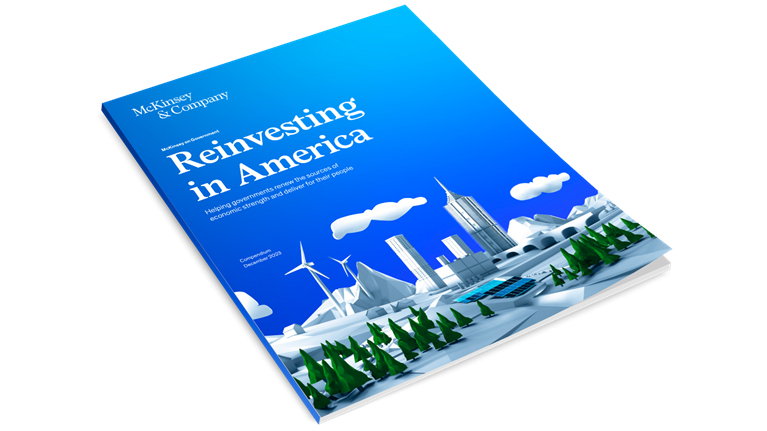Big plans are afoot to build in the United States. The country needs additional energy generation capacity, transmission lines, broadband, rail lines, and more. The good news is that plenty of providers are lining up to build these projects. More than 650 infrastructure projects tracked by the Permitting Dashboard are awaiting federal approval to begin construction.1 The bad news is that these projects will likely be waiting for a long time. Large infrastructure projects in the United States face permitting wait times stretching for years.
The intentions of permitting are to safeguard the health and property rights of communities, preserve ecosystems, uphold air and water quality standards, protect cultural and historical landmarks, and mitigate the effects of climate change. Many times, permitting statutes have proved critical in protecting Americans against the potentially harmful effects of proposed development. The National Environmental Policy Act (NEPA) and the National Historic Preservation Act (NHPA) were meaningful advancements that have afforded local and tribal groups a legal platform to advocate for—and ensure—robust environmental reviews on their traditional lands.2 Natural ecosystems are invaluable both in their own right and in the services they provide to societies—for example, clean air, clean water, quality soils, climatic regulation, and recreation. Permitting has played an important role in protecting these ecosystems, whose critical benefits must be preserved.
Yet as the gap grows between the country’s existing infrastructure and what is needed, many stakeholders are asking whether permitting could achieve these objectives more quickly. As permitting increasingly becomes a topic of focus, it is important that proposed reforms improve the effectiveness of permitting both in preventing harms to people and ecosystems while also enabling development that will benefit those people and ecosystems. Although substantial benefits may arise from shortening permitting timelines, thoughtful reforms do not seek the elimination of permitting review. Ensuring social and environmental safeguards and meeting America’s infrastructure needs doesn’t have to be a zero-sum game.
To understand the scope of this problem, we used multiple lenses to estimate the federal permitting timeline costs for US infrastructure stakeholders, including the public. We estimate that $240 billion to $280 billion in infrastructure capital expenditures across eight key sectors enter the federal permitting process each year. We find that each dollar, on average, takes about four to five years to move through permitting. These findings combined suggest there is $1.1 trillion to $1.5 trillion of infrastructure capital expenditure currently in federal permitting, costing stakeholders billions of dollars in lost revenue and withholding project benefits, including increased GDP, increased power generation capacity, lower carbon emissions, and opportunities for public transit.
In response to these estimates, we highlight reforms that could empower the US federal government to streamline permit reviews and unlock necessary infrastructure.
Critical infrastructure is needed and subject to federal review
In the United States, infrastructure projects may face several layers of permitting, including at the federal, state, and local or municipal levels. For some sectors, such as housing, permitting is primarily a state or local exercise. Larger infrastructure projects—in energy, transport, communications, or manufacturing, for example—are likelier to be subject to federal permitting, which is the focus of our analysis.
The United States is striving to address the growing need for infrastructure: The Infrastructure Investment and Jobs Act (IIJA) authorized approximately $1.2 trillion for infrastructure; the CHIPS and Science Act dedicated around $53 billion to semiconductor manufacturing; and environmental initiatives received most of the approximately $152 billion in infrastructure spending from the Inflation Reduction Act.3 As the volume of infrastructure projects increases, so does the need for permitting efficiency.




Larger infrastructure projects typically require federal permitting under NEPA, which requires federal agencies to assess a project’s environmental impact, including effects on natural and historic resources and communities (see sidebar “National Environmental Policy Act”). Roughly 100,000 actions face NEPA review every year, from the largest infrastructure projects in energy, transportation, and manufacturing to smaller projects such as short-term land usage by individuals and small businesses.4
Projects may also need to obtain some combination of approximately 60 project-specific federal permits tracked by the Permitting Council.5 Specific project characteristics define which permits are needed (for example, Clean Water Act and Clean Air Act permits; US Coast Guard bridge permits; migratory-bird permits; and Marine Protection, Research and Sanctuaries Act permits). Some of these permit processes remain unstandardized, decreasing the predictability of timelines.
Litigation can delay projects and introduce new expenses. Approximately 30 percent of projects undergoing an environmental impact statement (EIS), the most involved type of review under NEPA, face litigation; nearly 90 percent of plaintiffs in these cases claim a NEPA violation, among other legal objections.6 These claims are presented by a diverse set of plaintiffs—including nongovernmental organizations (NGOs), local governments, and individuals—often alleging inadequate analysis in an EIS or failure to consider a reasonable range of alternatives.
Permitting timelines are lengthy and costly
While long federal permitting timelines have attracted public attention, research quantifying their effects on infrastructure development remains limited. Our analysis addresses this knowledge gap, using government data to calculate the impact of long timelines using several measures (see sidebar “Methodology”). For each of our analyses, the estimated impact was substantial.
Our research confirms that the permitting process for larger, more expensive projects is typically far longer than it is for smaller projects. As a result, calculating the average permitting time across all projects (agnostic to and undifferentiated by size) underestimates the substantial social and economic impacts of permitting for these larger initiatives. We enlist weighted averages to address this nuance.
Through that approach, we estimate that the average proposed project dollar takes four to five years to move through the permitting process, with large variations by sector: Manufacturing dollars take two to three years to move through permitting, for example, while mining dollars take eight to nine years (Exhibit 2). The longest wait times are for projects requiring an EIS review, which also tend to be the largest projects.

Projects subject to litigation in district courts typically face delays of 1.0 to 2.0 years, and those that appeal in circuit courts (approximately one-third of all NEPA-related cases) require an average of 4.2 years to resolve.7 Despite these timelines, NEPA-related litigation rarely leads to meaningful change; 80 percent of appeals cases between 2013 and 2022 were decided in favor of federal agencies.8
Slowdowns in the permitting process can increase costs, hinder economic growth, and create negative effects on society and the environment. While some amount of value will always be awaiting permitting review, unlocking backlogged infrastructure could reduce these losses. We estimate that at any given time, reducing the federal permitting timeline by only one year could unlock a minimum of $22 billion in returns on invested capital among projects seeking approvals.9
Economic impact
While permitting requires billions of dollars in direct spend—$5 billion to $14 billion, by our estimate—it also leads to indirect costs (Exhibit 3). The four-to-five-year permitting timeline means that the unrealized returns on projects in the permitting pipeline amount to $100 billion to $140 billion each year, roughly half of the proposed capital expenditure entering the federal permitting pipeline every year. Construction costs can increase 24 to 30 percent over project timelines, spurred mainly by material and labor cost inflation and added overhead costs.

Capital tied up in permitting doesn’t contribute to the economy, which limits GDP growth. To quantify this, we estimated the induced GDP effects—including unrealized household spending by workers and suppliers paid to execute the project—of capital in the permitting queue to determine the second-order effects of these timelines. We found $1.7 trillion to $2.4 trillion in unrealized cumulative GDP.
Society and the environment
Accelerating federal permitting could streamline the fulfillment of citizens’ basic needs, such as access to electricity. Heightened efficiency across key sectors supports environmental objectives by increasing access to renewable energy and public transportation. The lengthy pace of permitting amounts to a missed opportunity for the United States to power 38 million to 54 million households and reduce annual carbon dioxide emissions equal to the amount emitted by 17 million to 26 million gas-powered vehicles, 6 to 9 percent of the total number of registered vehicles in the United States in 2025. In addition, approximately 2 percent of all US transit journeys are tied up in permitting.
These costs and impacts represent only those that we could quantify. Other costs are less knowable but are almost certainly present. For example, the desire to avoid longer permitting reviews may incentivize suboptimal project designs, such as avoiding federal land, that minimize permit exposure. Fear of litigation often leads to “litigation proofing,” which can cause agencies to significantly exceed recommended EIS page lengths, durations, or both, expending more resources in an effort to preempt lawsuits and prolonging the prelitigation period of the review process.10 Furthermore, the United States could be losing out on private capital from investors who deem the risk and unpredictability of lengthy timelines as too high.
Finally, the permitting process is felt socially and environmentally, as the public may lose trust in a process it perceives as inefficient. As permitting causes projects to become stalled or even canceled, the costs of inefficient and insufficient infrastructure in the United States—amounting to thousands of dollars per household annually—continue to accumulate.11
Improvements to federal permitting are possible
Inefficiencies in federal permitting are becoming more widely known. Political focus has increased as well, with the Council on Environmental Quality (CEQ) issuing an interim final rule changing authority over NEPA procedures and granting agencies more latitude to deviate from standardized processes.12 While debate continues over the right structures and practices to support federal permitting, evidence from initiatives launched within US borders and beyond suggests that efficient permitting and environmental and social protection can go hand in hand (see sidebar “Improvements to federal permitting are possible: Examples from abroad”).
Indeed, the United States has previously acted to improve the permitting process. Over the past five years, the median duration of EIS reviews has decreased substantially (Exhibit 4). This is no accident. The Fiscal Responsibility Act (FRA) of 2023 was designed to reduce timeline durations, streamlining the review process by creating more pathways for projects to receive categorical exclusions, shortening the timeframe on all NEPA reviews.13 Similarly, Title 41 of the Fixing America’s Surface Transportation Act (FAST-41) of 2015 implemented standards to expedite EIS litigation, including reductions to the statute of limitations on legal objections and developing publicly posted timetables for federal environmental reviews and authorizations. Recent available data shows a relative rise in categorical exclusions, a relative decline in the number of EIS reviews, and an absolute decline in projects subject to NEPA reviews.14 This may be driven in part by the introduction of 125 categorical exclusions across 15 federal agencies since 2021.15

The United States has also fast-tracked permitting for prioritized sectors and on special occasions. The US government has established several governance mechanisms to accelerate permitting, including appointing senior agency officials to the Permitting Council and creating a range of White House entities designed to accelerate permitting in certain areas (for example, the White House Clean Energy Innovation team and the National Energy Dominance Council). After the passage of the CHIPS and Science Act, which provided funding for semiconductor manufacturing and research, Congress passed the Building Chips in America Act of 2023, which exempts projects receiving CHIPS and Science Act funding from NEPA review.16 NEPA also includes provisions that can waive environmental review for projects following disasters. When an Interstate 95 overpass collapsed outside of Philadelphia in 2023, NEPA reviews were waived so that the busy highway could resume normal patterns as soon as possible. With construction workers working around the clock, the overpass was rebuilt in 12 days.17
Tactical reform can unlock greater progress in the United States
To build upon this momentum and to help identify the strategies that stakeholders could prioritize, we compiled a collection of more than 300 federal permitting proposals spanning seven core sectors and originating from a wide array of sources (for example, NGOs, House bills, and think tanks).18 We categorized these reforms to show the menu of options that could achieve permitting improvements while maintaining rigorous environmental standards (Exhibit 5).

While all of these strategies are designed to improve the federal permitting process, some may have more of an impact than others. Out of the six strategic categories we’ve identified, three stand out in their capacities to help reduce timelines and create a better stakeholder experience: implementing mechanisms to ensure timely completion, streamlining and accelerating the judicial process, and optimizing the flow of tasks and resources across the review process.
Implementing mechanisms to ensure timely completion
A lack of standardized NEPA review deadlines may intensify differences in the length of permitting processes by sector. Data from infrastructure projects sampled through 2018 suggest average preconstruction timelines (from notice of intent to record of decision) vary by more than a year, depending on the sector. Within sectors, the timelines vary considerably, with differences of more than six years between the minimum and maximum lengths for sampled projects from the same sectors.19 These timelines are, increasingly, the focus of discussions and announcements—for example, the US Department of the Interior recently released plans to abbreviate the duration of EIS reviews for prioritized energy projects.20
A few concrete steps toward the enforcement of timely completion, such as setting deadlines for specific phases of project development and introducing incentives including compensation for delays, can shorten timelines substantially. NEPA reforms in 2023 under the FRA present an example of how setting application page limits and enforcing deadlines can lead to more timely completion of EIS reviews.21 The percentage of EIS reviews that took more than two years to complete dropped from 71 percent in the pre-FRA period of 2010 to 2023 to 61 percent in the period following its enactment, from 2023 to 2024. In its successful outcomes, the FRA demonstrates a need for continually reassessing processes and setting stretch targets with incentives for further timeline reduction.22
Streamlining and accelerating the judicial process
Though agencies win about 80 percent of EA and EIS lawsuits, litigation results in project delays of an average of more than four years.23 New policy initiatives attempt to reduce delays while preserving opportunities for community members to speak up and introduce litigation. Existing key proposals seek to raise the litigation standards within the current system, including specifying a statute of limitations, limiting court authority or discretion to invoke NEPA as a ground for injunction, and limiting standing to affected parties and those who participated in the underlying NEPA proceeding. Other initiatives present new judicial entities and structures tailored to the federal permitting process, such as a technical court with jurisdiction over federal permitting decisions and an accelerated review schedule for acting on remanded or vacated permit decisions. FAST-41 introduces a statute of limitations on NEPA suits and shortens the statute of limitations to two years, from six years.24 While the FAST-41 is voluntary (agencies currently abide by the restrictions to benefit from the support infrastructure), projects opting into FAST-41 receive decisions nearly 18 months faster than projects not participating.25 Mandating FAST-41 policies and expanding its focus beyond NEPA permitting could yield substantial improvements in the speed of permitting.
Optimizing the flow of tasks and resources across the review process
While reforms that introduce permitting and litigation timelines encourage action from responsible parties, thoughtful planning around task and resource flows is what enables agencies to meet the new standards. Administrative bottlenecks, outdated procedures, and a lack of staffing resources, capacity, and training are common drivers of long NEPA processing times.26 Recent federal initiatives show a shift in this direction; in April, a presidential memorandum directed agencies to develop a Permitting Technology Action Plan to improve their technological and data standards.27 The state of Pennsylvania serves as a strong example of process optimization in practice: It meaningfully improved permitting workflows at the state level, providing a model for other agencies to emulate.
A 2023 executive order from the governor of Pennsylvania mandated that state agencies conduct a thorough review of their permitting procedures, documenting and sharing their analysis within 90 days. Two new government offices assisted agencies in optimizing their workflows and adopting permitting dashboards.28 The offices supported agency employees directly, troubleshooting bottlenecks, allocating staff where they were needed most, and streamlining legal review processes and technical barriers. The process informed the design of the PAyback program, which reimburses citizens for permitting delays. In the first two weeks of its process improvement and backlog reduction effort, the Pennsylvania Department of Environmental Protection eliminated 73 percent of the backlog (which comprised 1,750 applications), while keeping up with new submissions.
Although implementing policies such as these requires a nuanced understanding of the permitting landscape and stakeholder contexts, progress in permitting is possible. Continuing the work can have a profound effect on US infrastructure and the broader economy, while also maintaining the protections that permitting laws have afforded Americans to date.



